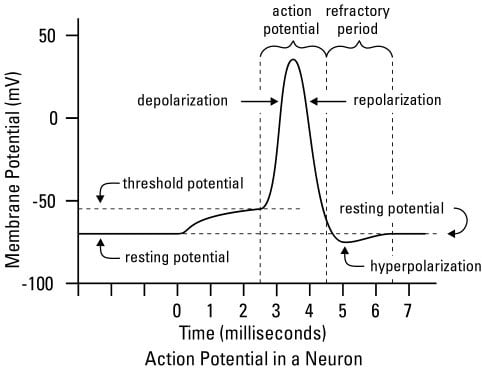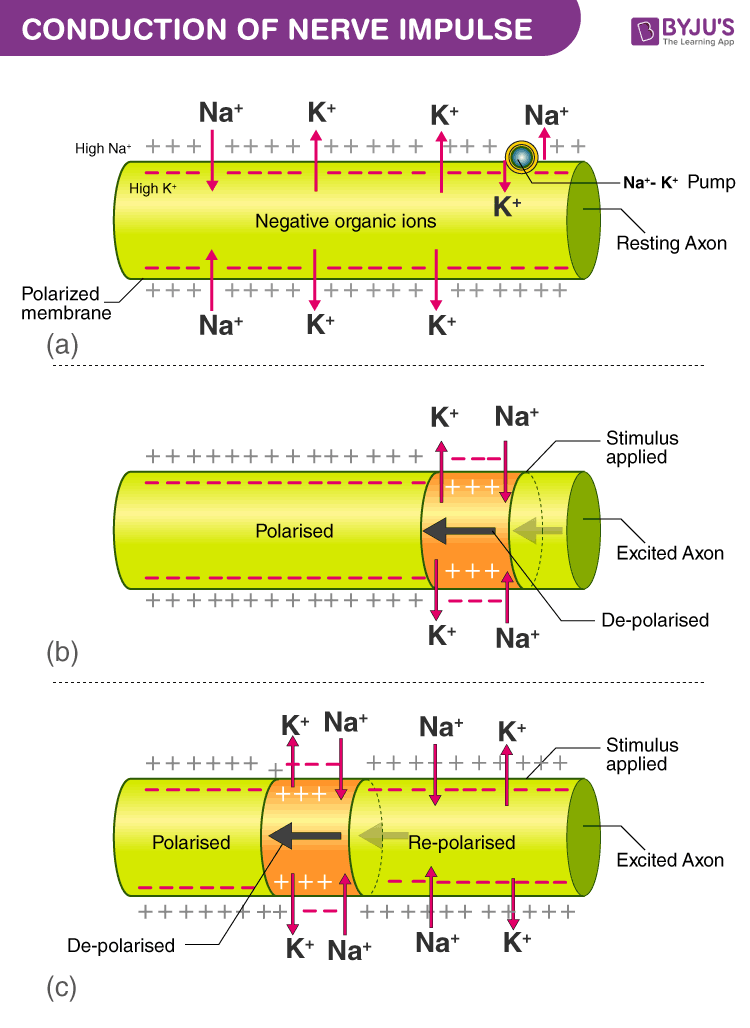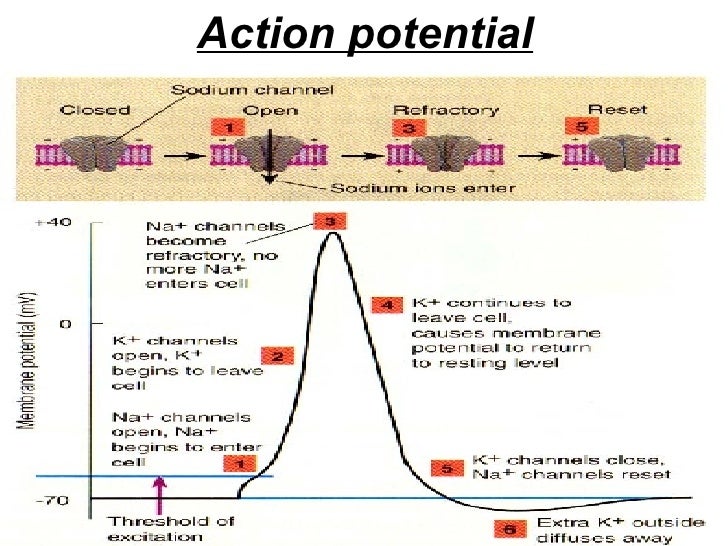It is the main mechanism used to carry information inside a neuron. Neurophysiology of Nerve Impulses Activity 5.
 35 2b Nerve Impulse Transmission Within A Neuron Action Potential Biology Libretexts
35 2b Nerve Impulse Transmission Within A Neuron Action Potential Biology Libretexts
An action potential is part of the process that occurs during the firing of a neuron.

Action potential nerve impulse. The nerve impulse is an electrochemical signal. A nerve impulse is a sudden reversal of the electrical charge across the membrane of a resting neuron. Summary Action Potential vs Synaptic Potential.
It can be generated when a neurons membrane potential is changed by chemical signals from a nearby cell. If the stimulus is strong enough reaching a threshold of -55 mV an action potential is triggered. Each neuron receives an impulse and must pass it on to the next neuron and make sure the correct impulse continues on its path.
In this article we are going to discuss the first concept the action potential. Experiment Results Predict Question Stop Think Question. As an action potential nerve impulse travels down an axon there is a change in polarity across the membrane of the axon.
Session-2a868608-1b12-47bb-ef02-d1fb415ccdd2 Pre-lab Quiz Results You scored 100 by answering 4 out of 4 questions correctly. Synaptic potential is the potential difference across the post-synaptic membrane. Once the sodium channels open the neuron completely depolarizes to a membrane potential of about 40 mV.
We could stimulate an excitable cell chemically electrically or mechanically. It occurs when a neuron sends nerve impulses along the axon and depolarizes the cell body. At the time of an action potential the cell membrane energy changes quickly from negative to positive as like sodium ions flow into the cell through ion channels.
The resting membrane potential refers to the non-excited state of the nerve cell at rest. Nerve impulses have a domino effect. The Nerve Impulse HD Animation.
The reversal of charge is called an action potential. The signal causes gates in sodium ion channels to open allowing positive sodium ions to flow back into the cell. In the neuron an action potential produces the nerve impulse and in the muscle cell it produces the contraction required for all movement.
Suprathreshold stimuli also produce an action potential but their strength is higher than the threshold stimuli. A stimulus from a sensory cell or another neuron depolarizes the target neuron to its threshold potential -55 mV and Na channels in the axon hillock open starting an action potential. Definition An action potential is the result of a very rapid rise and fall in voltage across a cellular membrane with every action potential impulse similar in size.
This rapid increase is caused by ionic currents crossing the membrane through voltage-gated channels. Ligand-gated Ion Channels and Voltage-gated Ion channels. What is an Action PotentialNerve Impulse Events of the Action Potential.
Here one more concept now begins which is known as Action potential which is also called as nerve impulse when the electrical charges that travels besides to the membrane of a neuron. The stimulus brings about the change in membrane potential. Through a chain of chemical events the dendrites part of a neuron pick up an impulse thats shuttled through the axon and transmitted to the next neuron.
PhysioEx Lab Report Exercise 3. An action potential occurs when the nerve cell is in an excited state while conducting nerve impulses. In other words the neuron is said to fire.
After the delivery of the significant stimulus the resting membrane potential of -70 mV rapidly increases and this rapid change is called an action potential or in other words a nerve impulse which acts as a signal in the neurone. Process of transmission of Nerve Impulse Resting Membrane Potential. An action potential also called a nerve impulse is an electrical charge that travels along the membrane of a neuron.
Measuring Its Absolute and Relative Refractory Periods Name. Threshold stimuli are of enough energy or potential to produce an action potential nerve impulse. This process causes a rapid increase in the positive charge of the nerve fiber.
Action potential is the sudden fast transitory and propagating change of the resting membrane potential of neurons. So an action potential is generated when a stimulus changes the membrane potential to the values of threshold potential. It begins when the neuron receives a chemical signal from another cell.
During the action potential part of the neural membrane opens to allow positively charged ions inside the cell and negatively charged ions out. Nerve impulses are created by stimuli in the environment such as sight sound smell taste and touch. 14 February 2021 Session ID.
Now its time to introduce two types of ion channels. Action potential the brief about one-thousandth of a second reversal of electric polarization of the membrane of a nerve cell neuron or muscle cell. In response to a signal from another neuron sodium- Na and potassium- K gated ion channels open and close as the membrane reaches its threshold potential.
The response of a nerve or muscle cell to an action potential can vary according to how frequently and for what duration the action potentials are fired.
 Propagated Action Potential Is The Nerve Impulse Medical Laboratory Science Teaching Biology Human Anatomy And Physiology
Propagated Action Potential Is The Nerve Impulse Medical Laboratory Science Teaching Biology Human Anatomy And Physiology
6 5 Nerves Hormones And Homeostasis Bioninja
 35 2b Nerve Impulse Transmission Within A Neuron Action Potential Biology Libretexts
35 2b Nerve Impulse Transmission Within A Neuron Action Potential Biology Libretexts

 8 Schematic Overview Of The Action Potential I E The Nerve Impulse Download Scientific Diagram
8 Schematic Overview Of The Action Potential I E The Nerve Impulse Download Scientific Diagram
 Understanding The Transmission Of Nerve Impulses Dummies
Understanding The Transmission Of Nerve Impulses Dummies
 Ham Radio Vs Tasty Ham Part Ii Teaching Biology Anatomy And Physiology Medical Studies
Ham Radio Vs Tasty Ham Part Ii Teaching Biology Anatomy And Physiology Medical Studies
 Neuron Action Potential Made Easy Youtube
Neuron Action Potential Made Easy Youtube
 Nerve Impulse Conduction And Transmission Of Nerve Impulses
Nerve Impulse Conduction And Transmission Of Nerve Impulses



